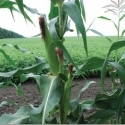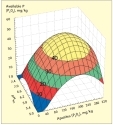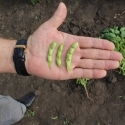21 Sep 2012
Topdressing Nitrogen in Modern Winter Wheat Varieties in Central Russia
By B.I. Sandukhadze and E.V. Zhuravleva
Winter wheat is the most important food crop occupying a considerable portion of sowing area in the Non-Chernozem zone of Russia. The Central part of the Non-Chernozem zone has a total cropped area of about 5M ha and is characterized by variation in climatic conditions. The frost-free period ranges from 112 to 148 days and climate needs to be considered by agricultural producers when selecting both crop management technologies and variety. Winter wheat has the highest potential biological productivity among other cereal crops cultivated in the region.
Even though winter wheat was grown on individual estates as far back as the beginning of 20th century (Sandukhadze et al., 2003), it is a relatively new crop for the central Non-Chernozem region of Russia. In less than a century, breeders have developed wheat varieties that are well adapted to the conditions in this region, and planted areas have increased dramatically. Currently, the area planted in Russia to only one winter wheat variety, Moskovskaya 39, developed in the Laboratory of Winter Wheat Breeding, Moscow Research Institute of Agriculture “Nemchinovka”, is more than 3 M ha. This and other new varieties such as Galina, Nemchinovskaya 24, and Moskovskaya 56 allow more effi cient crop management including the response to fertilizers. It is generally accepted that crop agronomy contributes half of the realized yield response and variety gives the other half, and only the combination of these two components, expressed in developing modern varieties, allows the full impact of both to be seen as increased good quality grain.
Nitrogen fertilizers have a large effect on grain yield and quality on almost all soil types. Nitrogen regulates growth, increases grain protein and gluten content, and has a positive effect on yield (Mineev and Pavlov, 1981). The requirement for N is especially high in the Central area of the Non-Chernozem zone. These soils often have organic matter contents less than 1.7 to 2.1% and total N and mineral N are also low. The application of N fertilizers is now considered the most effective and effi cient strategy to increase yield and improve grain quality. It is also important, at the same time, to maintain an adequate supply of other nutrients to the crop.
Summarized data indicate that winter wheat requires 30 to 35 kg N, 13 to 16 kg P2O5, and 23 to 26 kg K2O per tonne of grain with the corresponding amount of straw. In general applied N gives a 30 to 60% yield response. Nitrogen uptake is relatively low after planting in the fall and active uptake occurs as growth resumes in spring and continues through to the beginning of heading. By then, plants take up two-thirds of the total N requirement. Demand increases again after grain formation and fi lling and during this period the crop takes up the remaining 25 to 30% of N requirements. For winter wheat, the prolonged cold weather and soil compaction in spring can reduce N mineralization so that nitrate content in the arable layer may be 6 to 7 times lower than is required for normal development of plants (Sozinov and Zhemela, 1983). Spring N topdressing is an important strategy for high quality and high yielding winter wheat crops. The timing of spring topdressed N, the rate to use and the number of splits depend on weather conditions, status of the crop stand, soil N supply, and wheat variety. Plant response to fertilizer is closely related to genetically fixed characteristics specifi c to a genotype (variety) (Sandukhadze et al., 2003).
Experiments on the effi ciency of topdressed N fertilizer were conducted at the Laboratory of Winter Wheat Breeding during 1998 to 2007. Fourteen winter wheat varieties that represented different stages in the development of the breeding program (Zhuravleva, 2011) were selected for study. Soil properties were measured each year over the course of the study. Soil pHKCl varied from acid to close to neutral reaction and soil P (extracted with 0.2 M HCl) ranged from 237 to 497ppm P2O5. Hydrolytic acidity, varying from 2.09 to 3.59 cmol+/kg of soil, changed correspondingly to the exchangeable acidity. Soil K extracted with 0.2 M HCl ranged from 124 to 196 ppm K2O, soil organic matter content was 1.10 to 1.53%, or 1.27% on average.
Experiments were laid out in winter wheat fi elds preceded by tilled fallow with good weed control. The soil was a soddypodzol (Albeluvisol) with an arable layer depth of 25 cm. Winter wheat management was standard for the zone with P and K fertilizers broadcast before cultivation at 60 kg/ha for both P2O5 and K2O. Fungicide and insecticide treatments were applied as required along with appropriate herbicide applications.
Spring application of N was done either as a single topdressing [0, 60 (medium rate), and 120 kg N/ha (high rate)] in early spring just after snowmelt, or as split topdressings providing 30+30 and 60+60 kg N/ha (in spring just after snowmelt and during the stem elongation stage) or 40+40+40 kg N/ha (in spring just after snowmelt, during the stem elongation stage, and before fl owering). Nitrogen was applied as ammonium nitrate. In this summary, N responses for two cultivars from the current breeding program and two from an earlier program are compared.
Results and Discussion
Seasonal weather conditions were unfavorable for 3 years of the study as 1999, 2002, and 2007 had low growing season rainfall. Both temperature and moisture regime interact with variety as well as impact leaching and gaseous losses of N from the soil. These varying conditions can be summarized by a hydrothermal coeffi cient (HTC =ΣP/(0.1Σt), which combines precipitation (mm) in the given period (P), with the average daily airtemperature (t) above 10ºC (Selyaninov, 1937). Coeffi cient values < 1.0 indicate dry weather and values < 0.5 indicate a period of signifi cant drought. There was no signifi cant correlation between HTC and grain yield for the control treatments in the 14 varieties studied, but use of grain yield data from the topdressed N treatments improved this relationship. The correlation coefficient (r) was equal to 0.45 in modern varieties and 0.95 in varieties from the earliest breeding periods. Therefore, the application of N has allowed the varieties to respond to meet their genotypic yield potential in all conditions. Importantly, the application of N increased drought resistance of varieties as shown by of the higher relative yield increase due to N application in dry years.
Of interest are the responses to topdressed N of four modern winter wheat varieties, Pamyati Fedina and Moskovskaya 39 from an earlier breeding program, and Galina and Nemchinovskaya 24 from the current program. Our results show that plant height increased with higher N rates with the single N application for all four varieties (Figure 1). Varieties had achieved their maximum height with a single application of 120 kg N/ha. Among four studied varieties, the Moskovskaya 39 variety was the tallest and the Nemchinovskaya 24 the shortest. Where N was split, plants appeared to be not as tall if compared with a single N application; however, this decrease was not signifi cant and had no effect on lodging resistance. It should be noted that all four varieties are short-stem varieties, and are generally considered resistant to lodging with increasing N rates.
Some researchers recommend splitting topdressed applications of N fertilizer to better match supply and demand because N can be lost to the environment if applied early in crop growth when uptake is slow. However, our research has shown that splitting N application is not always an efficient measure to increase the yield of winter wheat (Table 1). As is the case for a single topdressing of N, the infl uence of weather conditions is also large for split N applications, but the effect is often expressed to a lesser extent. The three-factor analysis of variance showed that when N is split-applied “year” accounted for 46% of the variation, while “variety” and “fertilizer” shared the remainder.
Thus, the weather in each year should be considered when assessing N use effi ciency, including the effect of fertilizer timing and splitting. For example, the highest yield of Moskovskaya 39, Pamyati Fedina, and Nemchinovskaya 24, was in the very wet year of 2005, and this was obtained when N was topdressed as two splits applied as 60+60 kg/ha. On the other hand, Galina gave the highest yield with a single N application at 120 kg N/ha. The highest yield of Moskovskaya 39 and Pamyati Fedina varieties in conditions of sporadic rainfall in 2006 was from a single application of 120 kg N/ha, while Galina and Nemchinovskaya 24 gave the highest yield from the treatment with two splits of 60+60 and 30+30 kg N/ha, respectively.
Agronomic effi ciency of N (AEN, Dobermann, 2007) was calculated from these experiments and it varied from 12.7 to 39.0 kg of grain/kg N over 3 years for the single and split topdressing N rates (Table 1). The AEN for Pamyati Fedina increased from 14.5 to 23.7 kg grain/kg N when N was applied in two splits (30+30 kg N/ha) rather than a single topdressing of 60 kg N/ha. This response was seen in each year during our 3-year study. In general, the highest benefi t from topdressed N was found in the newer varieties—Galina and Nemchinovskaya 24.
Our research indicates that wheat varieties from the modern period (Nemchinovskaya 24 and Galina) have the highest yield and are more responsive to N fertilizer than the other varieties studied. Our analysis of yield components revealed that N application increases the number of kernels per wheat spike and this increase can be explained by the reallocation of assimilates to wheat spikes during stem elongation and, hence, the spikes formed with more kernels per spike. For example, under the unstable weather conditions in 2006, the highest yields for Pamyati Fedina were with two splits (30+30 kg N/ha) and three splits (40+40+40 kg N/ha). This response was a consequence of higher kernel weight in the case of two splits, but was due to more fertile tillers under three splits. The highest yield for Moskovskaya 39 was from a single topdressing at 120 kg N/ha, but this variety produced considerably more fertile tillers with 30+30 kg N/ha, while 40+40+40 kg N/ha increased both kernel number and kernel weight. Nemchinovskaya 24, like Moskovskaya 39, produced high yields in three splits. In this case, maximum yield was obtained with 30+30 kg N/ha due to more fertile tillers and higher kernel weights, while a high response to 40+40+40 kg N/ha generated a signifi cant increase in fertile tiller number, and the single N application at 120 kg N/ha increased both kernel weight and number per spike. The maximum yield of Galina was attained with two splits of 60+60kg N/ha and this increase was a consequence of considerable improvement of all yields components.
Our research results indicate a high effi ciency of topdressed N in winter wheat although these data also show that split applications are not always more effi cient than a single topdressing. The effi ciency of either single or split applications of N fertilizer is strongly dependent on weather conditions. According to data obtained in our experiments, modern Russian wheat varieties such as Nemchinovskaya 24 and Galina have both the highest yield and the largest response to N fertilizer. BC
Dr. Sandukhadze is Head, Laboratory of Winter Wheat Breeding, Moscow Research Institute of Agriculture “Nemchinovka” and Academician of the Russian Academy of Agricultural Sciences; e-mail: priemnaya@nemchinowka.ru.
Dr. Zhuravleva is Head, Sector of Cereals and Fodder Cereals, Russian Academy of Agricultural Sciences; e-mail: zhuravla@yandex.ru.
The authors acknowledge Dr. V. Nosov, Director, IPNI Southern and Eastern Russia Region, for his comments during the preparation of this article.
References
Dobermann, A. 2007. In Fertilizer Best Management Practices: General Principles, Strategy for their Adoption and Voluntary Initiatives vs Regulations. Proc. IFA International Workshop on Fertilizer Best Management Practices. 7-9 March 2007, Brussels, Belgium. IFA, Paris, France. pp.1-28.
Mineev, V.G. and A.N. Pavlov. 1981. Agrochemical fundamentals to increase wheat quality. Moscow, Kolos. 288 p. (In Russian).
Sandukhadze, B.I., M.I. Rybakova, and Z.A. Morozova. 2003. Scientific fundamentals for winter wheat breeding in the Nonchernozem zone of Russia. Moscow, Russian Academy of Agricultural Sciences. 426 p. (In Russian).
Selyaninov, G.T. 1937. In World agroclimatic guide. Leningrad, Gidrometeoizdat. pp.5-27. (In Russian).
Sozinov, A.A. and G.P. Zhemela. 1983. The improvement of grain quality of winter wheat and maize. Moscow, Kolos. 270 p. (In Russian).
Zhuravleva, E.V. 2011. Scientific evidence for the increase in productivity and grain quality of the intensive winter wheat varieties in agriculture of the Central Nonchernozem region: Doctorate Thesis. Moscow. 40 p. (In
Russian).




